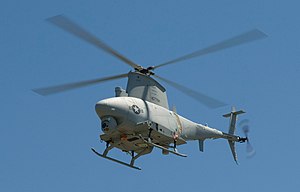TruthSeeker
PDF THINK TANK: ANALYST

- Joined
- Nov 27, 2008
- Messages
- 6,390
- Reaction score
- 3
- Country
- Location
Pressure Mounts on NATO as Drone Helicopter Goes Missing in Libya
Edward Yeranian | Cairo
NATO confirms that an unmanned helicopter drone was lost during a mission over Libya Tuesday, but denies claims that forces aligned with leader Moammar Gadhafi shot down an attack helicopter. The drone loss comes as the Alliance faces increasing pressures over the precision of its air attacks and alleged civilian deaths.
NATO spokesman Mike Bracken denied the claim by the Gadhafi government that it had shot down an attack helicopter, but confirmed that an unmanned drone was lost on Tuesday.
"At 0720 GMT, NATO received reports of an unmanned, autonomous helicopter drone, used by NATO forces, lost radar contact with the command center," Bracken announced. "This drone helicopter, unmanned, was performing intelligence, surveillance and reconnaissance over Libya to monitor pro-Gadhafi forces threatening the civilian population."
Libyan government TV showed footage of what appeared to be a downed helicopter, including part of a rotor blade. The TV claimed that a NATO Apache attack helicopter had been shot down near the town of Zlitan, 135 kilometers east of Tripoli.
It was not the first time that Gadhafi's forces claimed to have downed an Apache helicopter. None of the previous five claims have proven to be true. The unmanned drone helicopter lost Tuesday is considerably smaller than an Apache.
It was not immediately clear what brought down the drone, but Gadhafi's forces have been active in the coastal town of Zlitan, as rebels attempt to push westward from Dafniya.
The Libyan has claimed twice in recent days that NATO airstrikes hit civilian targets, including a compound owned by one of Gadhafi's loyalists. NATO spokesman Bracken said on Tuesday that the compound was a “command and control node,” with “17 satellite dishes on its roof.”
George Joffe, a North Africa expert at King’s College in London, says NATO allies are coming under increasing financial and political pressure to end the military operation in Libya quickly.
“Pressure is growing, certainly in the United States, after all the Obama administration now faces a possible censure in Congress, and in Europe there is growing anxiety about the resources available, particularly in Britain, where there has been complaints from the First Sea Lord, and also from the second in command of the Air Force, about the danger of overstretching very limited resources,” Joffe said.
Still, Joffe does not believe that the loss of a drone helicopter will make much of a dent militarily.
“The Gadhafi regime will boast about it and say that they can beat NATO forces. It will certainly make the Obama administration less willing to increase its commitments to the NATO operation, but beyond that… it may just be a question of writing off a loss,” Joffe said.
Pressure Mounts on NATO as Drone Helicopter Goes Missing in Libya | Africa | English
-----------------------------------------
Thought this was interesting that drone helicopters are being deployed .....
Edward Yeranian | Cairo
NATO confirms that an unmanned helicopter drone was lost during a mission over Libya Tuesday, but denies claims that forces aligned with leader Moammar Gadhafi shot down an attack helicopter. The drone loss comes as the Alliance faces increasing pressures over the precision of its air attacks and alleged civilian deaths.
NATO spokesman Mike Bracken denied the claim by the Gadhafi government that it had shot down an attack helicopter, but confirmed that an unmanned drone was lost on Tuesday.
"At 0720 GMT, NATO received reports of an unmanned, autonomous helicopter drone, used by NATO forces, lost radar contact with the command center," Bracken announced. "This drone helicopter, unmanned, was performing intelligence, surveillance and reconnaissance over Libya to monitor pro-Gadhafi forces threatening the civilian population."
Libyan government TV showed footage of what appeared to be a downed helicopter, including part of a rotor blade. The TV claimed that a NATO Apache attack helicopter had been shot down near the town of Zlitan, 135 kilometers east of Tripoli.
It was not the first time that Gadhafi's forces claimed to have downed an Apache helicopter. None of the previous five claims have proven to be true. The unmanned drone helicopter lost Tuesday is considerably smaller than an Apache.
It was not immediately clear what brought down the drone, but Gadhafi's forces have been active in the coastal town of Zlitan, as rebels attempt to push westward from Dafniya.
The Libyan has claimed twice in recent days that NATO airstrikes hit civilian targets, including a compound owned by one of Gadhafi's loyalists. NATO spokesman Bracken said on Tuesday that the compound was a “command and control node,” with “17 satellite dishes on its roof.”
George Joffe, a North Africa expert at King’s College in London, says NATO allies are coming under increasing financial and political pressure to end the military operation in Libya quickly.
“Pressure is growing, certainly in the United States, after all the Obama administration now faces a possible censure in Congress, and in Europe there is growing anxiety about the resources available, particularly in Britain, where there has been complaints from the First Sea Lord, and also from the second in command of the Air Force, about the danger of overstretching very limited resources,” Joffe said.
Still, Joffe does not believe that the loss of a drone helicopter will make much of a dent militarily.
“The Gadhafi regime will boast about it and say that they can beat NATO forces. It will certainly make the Obama administration less willing to increase its commitments to the NATO operation, but beyond that… it may just be a question of writing off a loss,” Joffe said.
Pressure Mounts on NATO as Drone Helicopter Goes Missing in Libya | Africa | English
-----------------------------------------
Thought this was interesting that drone helicopters are being deployed .....














